New York State is known for its world-class cities. But it’s the many different types of habitats in New York that attract snakes. The state has mountains, many lakes and rivers, and plenty of grasslands that make the perfect environment for some snakes.
New York’s snakes begin waking up in mid-March; then, cold weather begins creeping in around late October, so by this point snakes the state’s snakes are looking for safe little cubbies to tuck into for the winter. But during those active months, up to 18 different types of snakes cruise around in New York state.
Because of its colder northern climate, New York doesn’t have as many snake species as many other states. Additionally, there are only three venomous snakes. While you’re out hiking, kayaking, or enjoying some of the beautiful state parks around the state, you could find yourself nose-to-nose with a few different snakes. Read on for more!
Northern Black Racer (Coluber constrictor constrictor)
If you see a thin strip of black racing out of your field of vision it is probably a northern black racer. However, you will only find black racers in the southeastern and southern parts of the state — mostly near the state border.
Black racers are very long and thin snakes that can grow up to five feet long. Their superpower for both hunting and escaping predators is their speed — which can be around four miles per hour. You’re not likely to see much more of these snakes than their tails as they race away. However, if you corner one will probably try to bite you. Repeatedly. Fortunately, the northern black racer is harmless, so a bite won’t cause any major damage — but it can hurt.

The black racer is an agile and very fast animal that can “run” (crawl) 4 miles per hour when it is threatened, hence the name “racer.”
©Breck P. Kent/Shutterstock.com
Eastern Garter Snake (Thamnophis sirtalis sirtalis)
The eastern garter snake is widespread across New York and mainly eats small amphibians and lizards. These snakes are small, thin, and typically have a bright dorsal stripe over their dark base color, a lengthwise stripe on either side of their bodies. They rarely exceed four feet long and have large eyes.
Like other garter snake subspecies, eastern garter snakes prefer wetter habitats. They are often found near permanent water sources and eat a fair amount of amphibians. Eastern garter snakes also live in residential yards under logs, piles of mulch, or grass clippings that aren’t cleaned up right away.

One of the most cold-tolerant snakes in the world, garter snakes are usually active early and later in the year than other species.
©Erik Agar/Shutterstock.com
Maritime Garter Snake
Maritime garter snakes have bigger heads and a bold brown checkerboard pattern. They’re native to the far eastern areas of New York.

Their bold checkered pattern stands out, even if their dorsal stripe is muted.
©Lisa Crawford/Shutterstock.com
Shorthead Garter Snake
Extremely rare! The only recorded sightings of shorthead garter snakes are in the western portions of New York.

Shorthead garter snakes are extremely rare in New York.
©Eric Dale/Shutterstock.com
Ribbon Snake (Thamnophis saurita ssp.)
They’re often found in or around water and mainly feed on fish, frogs, and other aquatic animals. Two subspecies occur in New York:
Northern ribbon snake
You’ll find these mostly in the north and west regions of New York.

Northern ribbon snakes are usually darker than their southern counterparts.
©John Czenke/Shutterstock.com
Eastern ribbon snake
This subspecies occurs mainly in the southeastern areas of New York.
These harmless snakes look a lot alike, except that the northern ribbon snake is dark brown or black with a bright yellow dorsal stripe; compared to the eastern ribbon snake’s brown with bright yellow stripe.

Eastern ribbon snakes are usually brown with bright yellow or orange stripes.
©Jay Ondreicka/Shutterstock.com
Smooth Green Snake (Opheodrys vernalis)
You’d think that with bright green skin, these roughly two-foot-long snakes would stand out. But they don’t. Turns out that bright green color helps smooth green snakes blend in with all the vegetation like they aren’t even there.
These harmless snakes eat mostly crickets, grasshoppers, and caterpillars, but they’ll also eat other small invertebrates and amphibians. They’re native to most of New York and have heavier populations in various pockets around the state.

Smooth green snakes
have slender bodies and measure no more than 26 inches long.
©Kristian Bell/Shutterstock.com
Queen Snake (Regina septemvittata)
There aren’t many queen snakes in New York. Despite the regal name, queen snakes are small. They’re similar in size to garter snakes and are often less than 24 inches long. You’ll typically find queen snakes in far western New York.
Queen snakes are dark brown or olive in color and have four cream or tan colored stripes running down their bellies. With specific habitat and dietary needs, queen snakes are restricted to areas that have clean flowing water. Recently molted crayfish make up most of their diet, although they’ll also eat fish and small amphibians in a pinch.

The queen snake is a non-aggressive, non-venomous snake found in North America
©Jason Patrick Ross/Shutterstock.com
Eastern Hognose Snake (Heterodon platirhinos)
Eastern hognose snakes like loose sandy soil and have been known to take up residence in farmland and around rush piles. When you’re walking around your property or hiking through some of eastern New York’s stunning national parks you can find eastern hognose snakes in drier areas with loose soil for burrowing.
One characteristic that sets the eastern hognose apart is their upturned nose. This strange nose gives the hognose its name and makes it easy to identify. Eastern hognose snakes usually have a lighter base color with dark blotches, but many are so dark the pattern is hard to see. However, red, brown, and gray individuals also occur naturally. They are small snakes and rarely grow longer than 30 inches long.
Although they’re harmless to people, they are rear-fanged and have mild venom. However, their venom is only useful against their favorite food — toads!
These unusual snakes are most known for their dramatic defensive display that includes feigning death, complete with their mouth open and tongues hanging out. If you’re fortunate enough to encounter one of these in the wild, be sure to let it go along its merry way.

Eastern Hognose Snake
with flattened neck on sandy soil with grass. They have rectangular spots down the middle of the back that may resemble eyespots.
©IHX/Shutterstock.com
Eastern Milk Snake (Lampropeltis triangulum)
Eastern Milk snakes are harmless nonvenomous snakes, but they defend themselves aggressively. These snakes strike repeatedly and bite hard when cornered. So, if you spot an eastern milk snake, be careful about how you approach it. In most cases, simply giving it a little space for it to escape is enough.
Like many colubrids, they try to rattle their tails against dead leaves and other vegetation to make noise. Many people believe it’s an imitation of a rattlesnake. However, the fact that colubrids in Africa that have never seen a rattlesnake do the same thing raises questions on the validity. In any case, milk snakes that rattle their tails are issuing a warning — get away or it’ll bite!
Eastern milk snakes are widespread across New York. They are versatile and can live in forests, open woodland, swamps, prairies, farmland, and around gardens. They like to hide under buildings, in old barns, under logs, fallen trees, and mulch. If you live on or near a farm in northern New York you have a good chance of coming across one of these snakes.
Eastern milk snake colors vary, but those in New York usually have blotches outlined in black over a lighter base color. Their heads and necks are about the same width, and they range in size from 12 to 71 inches long. However, those in northern climates tend to stay smaller.

Eastern milk snakes are very beneficial animals, especially for farmers, as they hunt down small
rodents
often found on farm buildings and barns.
©Jay Ondreicka/Shutterstock.com
Common Watersnake (Nerodia sipedon)
One of eastern North America’s most common snakes is a watersnake. Also called northern watersnakes, common watersnakes are semiaquatic and mainly eat fish and amphibians. They’re heavy-bodied snakes with keeled scales that can grow to about four and a half feet long.
Common watersnakes have a lighter base color with darker, reddish brown bands on their necks that become blotches on their backs. Young snakes have brighter colors that fade and darken as they mature. Although they’re somewhat odd-looking, with their eyes set higher on their heads, they’re harmless. But these nonvenomous snakes defend themselves aggressively! Common watersnakes’ saliva contains a mild anticoagulant that will make you bleed for several minutes after being bitten.
Most reported common watersnake sightings are clustered in the southern portion of New York, but they can be found statewide.
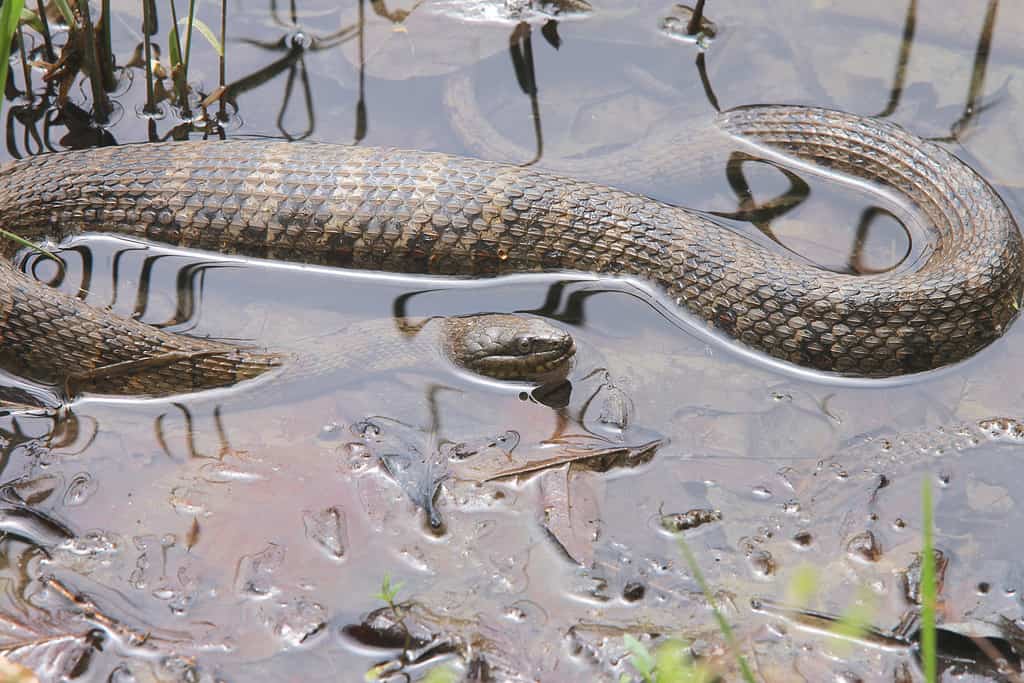
A Northern Water Snake (Nerodia sipedon) lays in shallow water at the edge of a lake.
©iStock.com/NajaShots
Dekay’s Brownsnake (Storeria dekayi)
Tiny and nearly everywhere in the eastern United States, Dekay’s brownsnake loves our gardens. They hide under rocks, logs, and leaf litter during the day and hunt for snails, slugs, and earthworms at night. The biggest Dekay’s brownsnake on record was a whopping…19 inches long. But, most of these snakes stay much smaller, around 12 inches.
Dekay’s brownsnakes are brown, tan, or gray with black dots alongside a lighter dorsal stripe. They often have slightly darker heads, but not always. These snakes almost never bite when you pick them up, and are completely harmless.
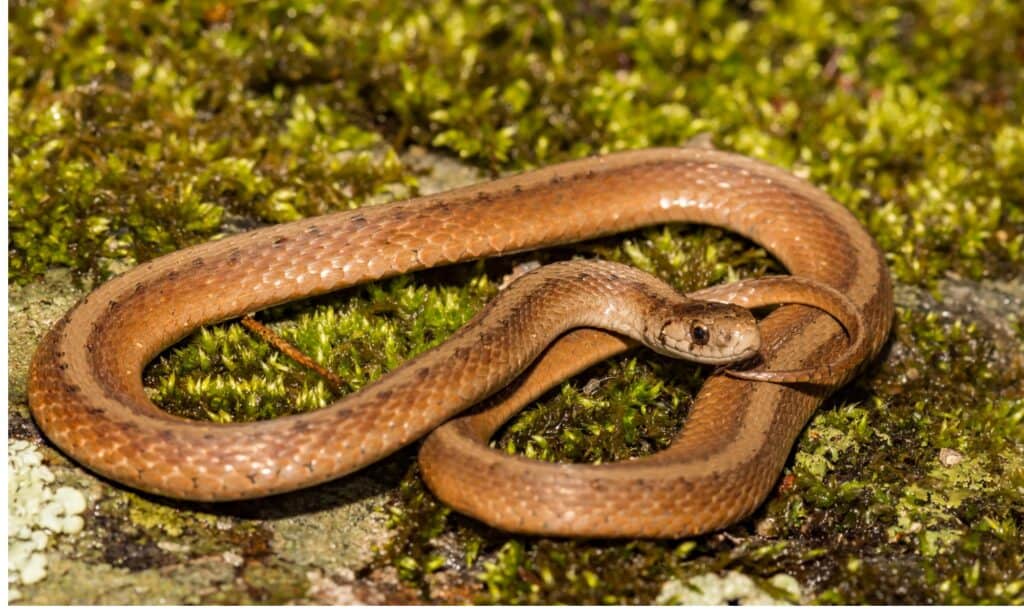
Northern brown snakes are the type species for Storeria dekayi
©iStock.com/JasonOndreicka
Red-Bellied Snake (Storeria occipitomacculata)
This close cousin to Dekay’s brownsnake inhabits many of the same areas. Red-bellied snakes are gorgeous little snakes that have brown, dark gray or black dorsal scales (sometimes with iridescence) and bright red to orange bellies. Harmless and shy, they hide under leaf litter, rotten logs, and other moist areas.
When threatened, these snakes curl up their bodies and show you their belly. Red-bellied snakes mostly eat slugs and snails and occur in most of New York state.
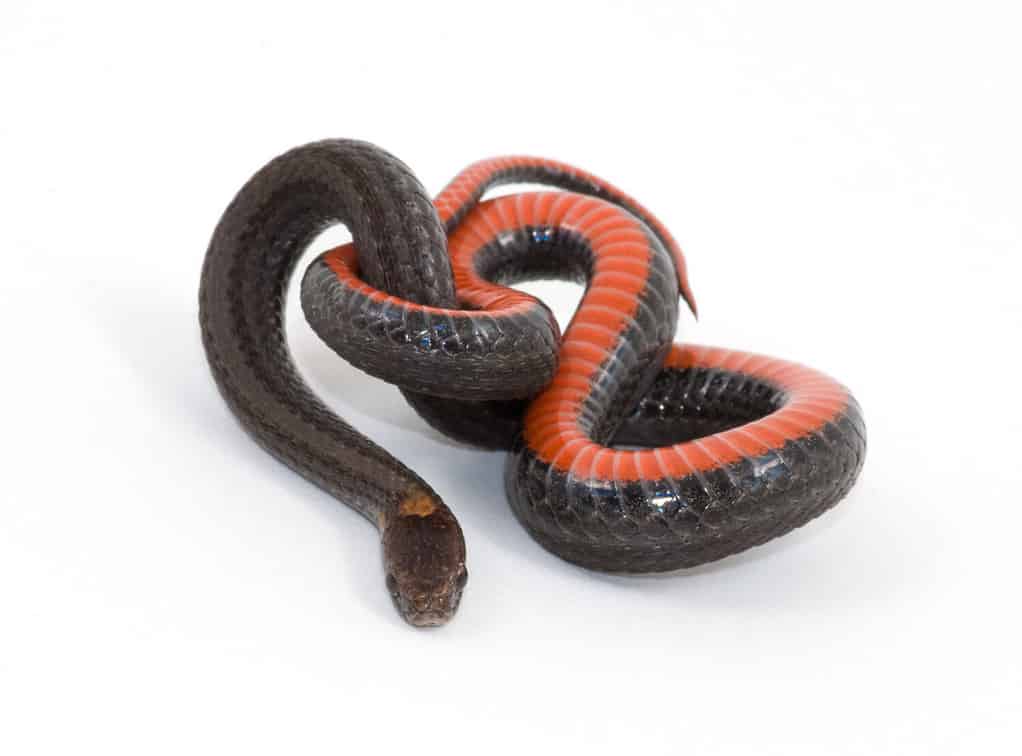
Red-bellied snakes are cousins to Dekay’s brownsnake.
©Gerald A. DeBoer/Shutterstock.com
Eastern Ratsnake (Pantherophis alleghaniensis)
New York’s biggest snake is also the most notorious. If you find a snake in a bizarre place, there’s a good chance it’s a ratsnake — there’s even a Facebook page dedicated to their antics: Ratsnakes in Predicaments. If that doesn’t tell you something about these slithering miscreants, nothing will!
Joking aside, eastern ratsnakes are also called black ratsnakes. They’re rodent control in ways that most pest control companies only dream of. Black ratsnakes are terrific climbers and you’ll find them in trees, shrubs, attics, garages, and probably chicken coops.
Black ratsnakes grow up to six feet long and are almost all black with white chins, necks, and some white speckling on their backs. As young snakes, they look similar to milksnakes without the reddish color to the markings and more space between their markings. Eastern ratsnakes are more common in eastern and southern New York where they have plenty of room to roam and prey to eat.
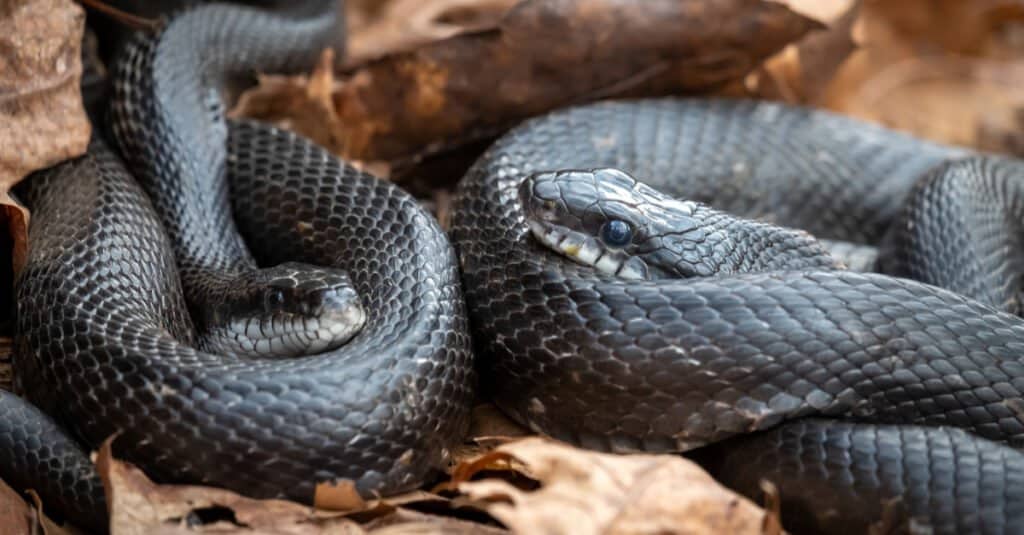
A pair of Eastern Ratsnakes (Pantherophis alleghaniensis) snuggle during the spring season.
©samray/Shutterstock.com
Ring-Necked Snake (Diadophis punctatus)
Small and reclusive, ring-necked snakes mainly eat salamanders. They usually stay under cover because they’re skin is more fragile than other snakes. These snakes are small and usually stay under about 12 inches long.
Ring-necked snakes in New York have a bright orange or red belly with a matching neck ring. These harmless snakes aren’t seen often because they spend most of their time undercover.
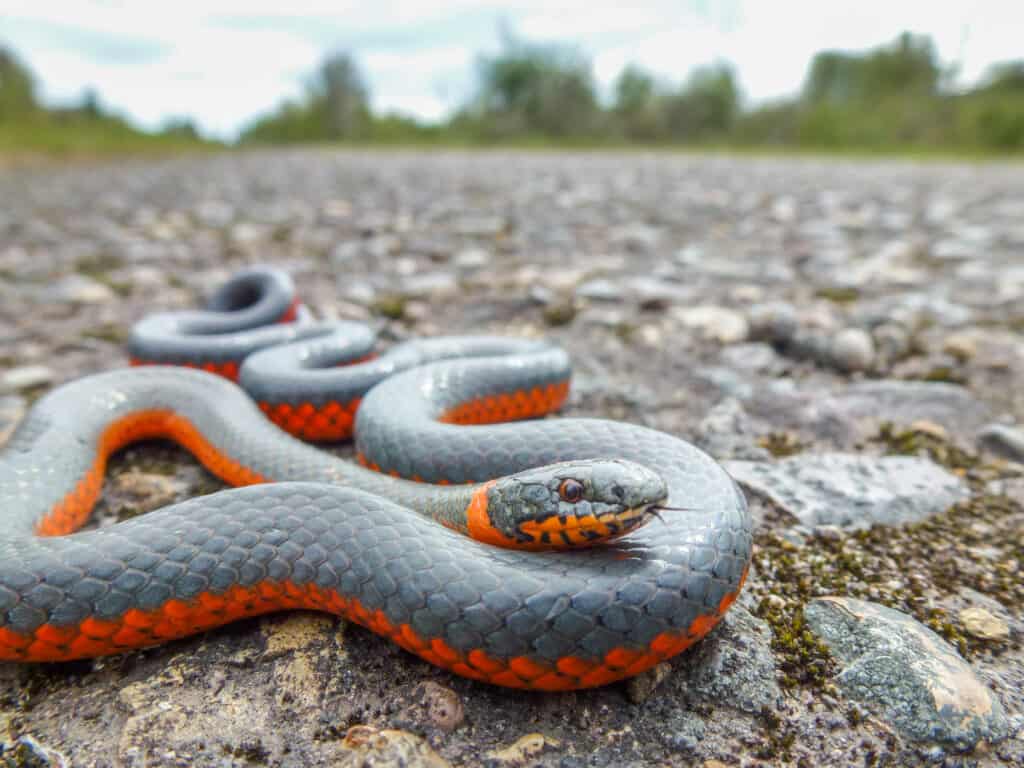
Ring-necked snakes occur in most of the United States, but people don’t see them often because they’re usually hiding.
©Tom Fenske/Shutterstock.com
Eastern Worm Snake (Carphophis amoena)
Native to the very southern portions of New York, the eastern worm snake looks like a worm until you get closer and discover they aren’t slimy!
These snakes have tiny eyes and spine-tipped tails. Their main prey is earthworms, so they stay underground in loose, moist soil where the worms live. This is also helpful for these tiny worm eaters because eastern worm snakes’ skin doesn’t hold moisture as well as other snakes.
Eastern worm snakes are extremely reclusive, so you’re not likely to see one. However, they stay pretty small and don’t exceed 13 inches.

Worm Snakes typically have dark tops and lighter-colored undersides
©Jason Patrick Ross/Shutterstock.com
Venomous Snakes In New York
Venomous snakes are rare in New York, making it unusual for anyone to get bitten by one. However, there are three different types of venomous snakes in New York so it’s smart to always be aware of what wildlife is around you even when you’re just out hiking or walking. Venomous snake bites are rare but they do happen.
The three venomous snakes in New York are:
Timber Rattlesnake (Crotalus horridus)
Timber Rattlesnakes like to stay hidden from people and predators so they prefer habitats that are rocky or rugged. In New York state, timber rattlesnakes prefer the mountainous regions. They also live in some of the state parks that are dotted across the state.
Unless you’re an avid hiker or one that spends a lot of time outdoors your chances of ever coming across a Timber Rattlesnake are small. As big and venomous as they are, often measuring five feet, they’re not aggressive and would rather you leave them alone.
Timber rattlesnakes have a lighter base color of brown, yellow, or gray with black chevrons or M-shaped saddle markings — they become solid black at their tail, leading to the nickname of velvet-tailed rattler. Their rattles are large and well-developed — the sound is unmistakeable! Melanism is pretty common with this species, so a solid black rattlesnake isn’t uncommon.
These snakes eat a variety of prey items which can include rodents, lizards, and smaller snakes. They’re not common in New York and most sightings are in the south and east areas.
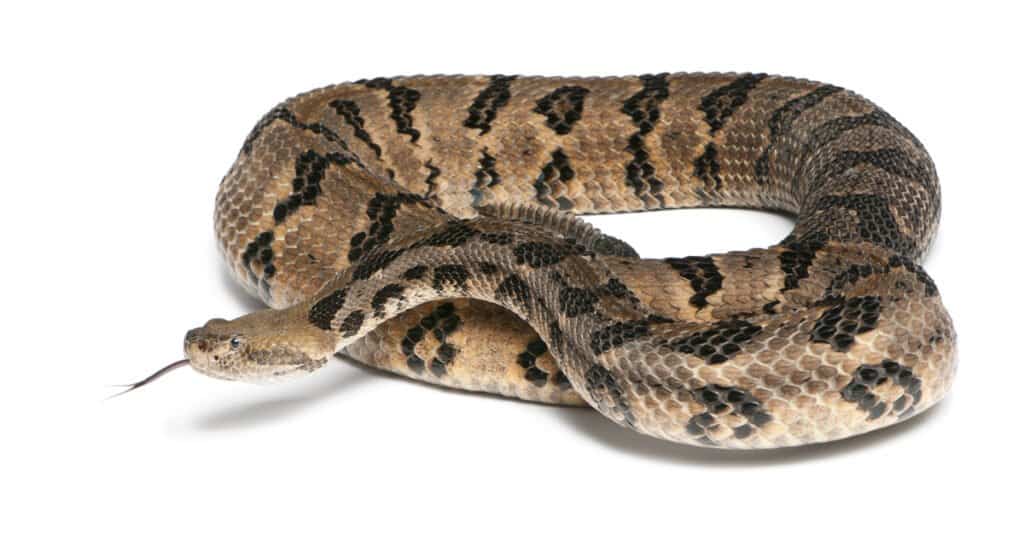
Timber Rattlesnake
©Eric Isselee/Shutterstock.com
Eastern Massasauga (Sistrurus catenatus)
The Eastern Massasauga rattlesnake is very small for a rattlesnake and generally only grows to about 30 inches long. But it’s still a rattlesnake and it can still hurt you pretty badly with a bite. Massasauga rattlesnakes vary in color but are usually dull and dark colored with olive, brown, or black bodies and brown or black markings. Their markings reflect their habitat which is usually fields, upland areas, and the edge of fields near forests. They can hide in tall grass, brush piles, old fallen trees, or foliage. When you’re hiking in areas of New York that could be habitats for Eastern Massasauga rattlesnakes pay close attention to everything around you and keep on the trail at all times.

Eastern massasaugas tend to like wetter areas near marshland.
©Vladislav T. Jirousek/Shutterstock.com
Copperhead Snake (Agkistrodon contortrix)
Venomous Copperhead snakes are forest creatures that live in the southern portion of New York. They’re the least venomous of the pit vipers in New York, which is great considering that they’re also the most numerous.
Copperheads blend into piles of leaves so perfectly that they’re virtually invisible. Their pattern mimics the leaf litter of the forest floor, and although they’re dangerous, they’re not aggressive. The problem is that they blend in so well that people step on them and get bitten.
These snakes eat a variety of small lizards and invertebrates. They’re opportunists and sometimes eat rodents too. Copperheads are stocky pit vipers but relatively small — they only measure about three feet long. However, the snakes do have a typical chunky head of a pit viper.

Northern copperheads prefer wooded areas in the hills.
©JacobLoyacano/Shutterstock.com
Summary of 18 Snakes of New York State
| Number | Snake Species | Venomous |
|---|---|---|
| 1 | Northern Black Racer | NO |
| 2 | Eastern Garter Snake | NO |
| 3 | Maritime Gartner Snake | NO |
| 4 | Shorthead Gartner Snake | NO |
| 5 | Eastern Ribbon Snake | NO |
| 6 | Northern Ribbon Snake | NO |
| 7 | Smooth Green Snake | NO |
| 8 | Queen Snake | NO |
| 9 | Eastern Hognose Snake | NO |
| 10 | Eastern Milk Snake | NO |
| 11 | Common Watersnake | NO |
| 12 | Dekay’s Brownsnake | NO |
| 13 | Eastern Rat Snake | NO |
| 14 | Ring-Necked Snake | NO |
| 15 | Eastern Worm Snake | NO |
| 16 | Timber Rattlesnake | YES |
| 17 | Eastern Massasauga | YES |
| 18 | Northern Copperhead | YES |
The photo featured at the top of this post is © Jason Patrick Ross/Shutterstock.com
Discover the "Monster" Snake 5X Bigger than an Anaconda
Every day A-Z Animals sends out some of the most incredible facts in the world from our free newsletter. Want to discover the 10 most beautiful snakes in the world, a "snake island" where you're never more than 3 feet from danger, or a "monster" snake 5X larger than an anaconda? Then sign up right now and you'll start receiving our daily newsletter absolutely free.
Thank you for reading! Have some feedback for us? Contact the AZ Animals editorial team.







